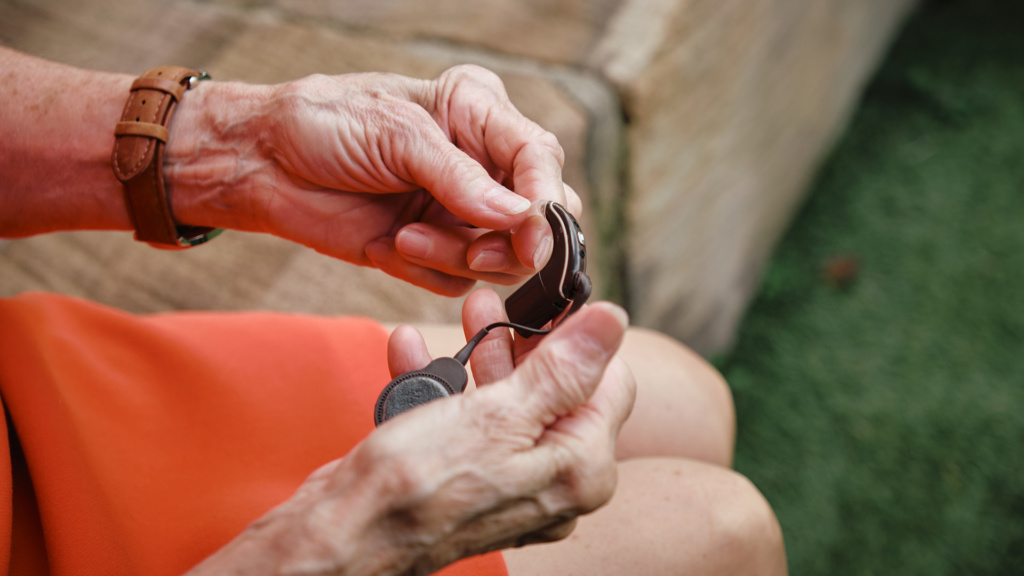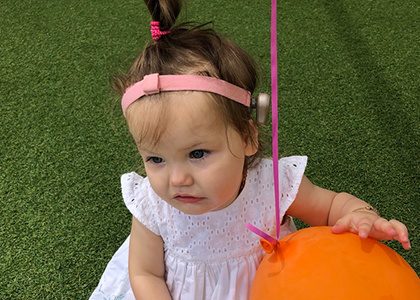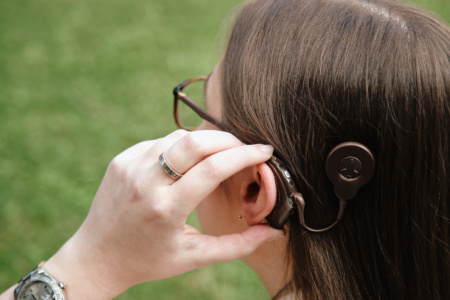For some people with hearing loss, hearing aids can make sounds louder, but not clearer. This is where implantable devices such as cochlear implants may be an option.
We are currently experiencing internet and phone issues in some of our centres. For all enquiries, please contact mail@hearandsay.com.au.
Hearing implants
Types of implants, eligibility and preparing for surgery
Fast facts
The first multi-channel cochlear implant invented in Australia by Prof Graeme Clark1
More than 92% of adults with significant hearing loss in Australia who could benefit from a cochlear implant haven’t explored the technology2
On average, children who attend Hear and Say who have severe to profound hearing loss receive their first cochlear implant at eight months old
Hearing implant devices
Our implant services
Backed by almost 30 years’ experience, Hear and Say offers specialist hearing implant services including:
- Cochlear implant evaluation and programming
- Support for other implantable devices, including bone anchored hearing aids and middle ear implants
- Specialised speech therapy to improve listening and communication skills
It’s a big decision to have hearing implant surgery. Our experienced audiologists support and guide you through the pre- and post-implant journey, and continue to work with you once you receive your hearing implant.

What is a hearing implant?
A hearing implant is surgically implanted so that it bypasses the normal hearing process. Rather than making sounds louder like a hearing aid, a cochlear implant does some of the function of the inner ear converting sounds into electric signals that stimulate the auditory nerve.
Cochlear implants have two parts – the internal component which is the implant itself, and the external component is the sound processor that is worn behind the ear. The sound processor captures sounds, and converts them into a coded signal that is transmitted through to the implant. The receiver stimulator package then decodes this signal and determines how much electrical current will be sent to each of the electrodes within the cochlea. Once the nerve endings are stimulated by these electrodes, the message is then sent to the brain via the auditory nerve.
Types of implantable devices
There are three types of implantable devices. The device most suitable for you depends on your specific type of hearing loss and any other health considerations. The team at Hear and Say in conjunction with your Ear, Nose and Throat (ENT) specialist can help you work out which will be most beneficial for you.
Cochlear implant
Recommended when hearing aids no longer provide enough benefit. Cochlear implants bypass the damaged part of the ear and stimulate the hearing nerve directly, to enhance the clarity of sound and improve speech understanding.
Bone anchored hearing device
Typically used by people with chronic middle ear infections, physical ear abnormalities (such as microtia and atresia) or disarticulation of the bones in the middle ear.
Middle ear implant
Suitable for a range of hearing loss types and offer an alternative for those unable to use or obtain benefit from traditional hearing aids.
News
Bone Conduction Hearing Devices
How do Cochlear Implants Work?
Who’s eligible for a cochlear implant?
Cochlear implants are suitable for people of all ages with significant hearing loss in one or both ears where a hearing aid is no longer enough. There are specific guidelines to determine if someone is eligible for a cochlear implant, including:
- minimal benefit from wearing hearing aids;
- medical assessment confirms there are no barriers to surgery; and
- motivated to attend all post-implant appointments such as programming sessions, rehabilitation and specialist speech therapy to practice listening in day-to-day environments


How to prepare for a cochlear implant
When getting ready for a cochlear implant there are a few steps everyone will follow, including:
Cochlear implant evaluation
Making the decision to get a hearing implant can be a life-changing experience. Firstly, you will undergo a comprehensive medical, audiological and speech and language evaluation to determine if you are a candidate. These tests include hearing test, speech discrimination with and without hearing aids, balance, MRI and psychological testing to determine your suitability for a cochlear implant.
Cochlear implant surgery
The cochlear implant surgery itself generally takes up to two hours and is undertaken by a specialised cochlear implant Ear, Nose and Throat (ENT) surgeon. The surgeon will insert the implant under your skin on top of your skull, and the little electrodes will be inserted into your inner ear. The implant is then tested to ensure that it is working before you leave theatre.
Cochlear implant switch-on
Once you have healed from the surgery the implant can be activated, or ‘switched on’ to sound. This generally happens roughly one to two weeks after surgery. This is when the listening program (known as a MAP) is set; at this appointment your audiologist will fine-tune the sound and keep in touch with how you’re progressing. The initial MAP is set conservatively to give your brain time to get used to all the new sounds its hearing. Over a series of appointments, your audiologist will increase the volume of your MAP so that you can ultimately hear the full range of sounds.
Potential risks of cochlear implantation
Cochlear implant surgery is generally safe and has very few risks. However, although unlikely, there are some risks associated with cochlear implantation, including:
- Loss of residual hearing
- Surgery may be needed to repair or replace a faulty device
- In addition to the above, there may be some surgical risks which your ENT will discuss with you

Who is suitable for a Bone Anchored Hearing Device
A bone anchored hearing device is generally suitable for someone who has single-sided hearing loss, permanent conductive hearing loss or mixed hearing loss. This device is also commonly used for people with hearing loss as a result of illness or infection.
There are specific guidelines to determine if someone is eligible for a bone anchored hearing device. An Ear, Nose and Throat specialist will determine medical suitability whilst an audiologist determines audiological suitability.
Bone anchored hearing implants also require a reasonably quick surgery to implant the internal device into the mastoid bone of the skull. This is what enables the bone conduction transmission of sound. Once you have healed from the surgery, the fitting of the external sound processer can take place.
Getting used to your hearing implant
After your cochlear implant has been switched on, your brain will need to adjust to the new signal it’s receiving and also to be trained to process sounds it hasn't heard for some time. This is where specialised speech therapy is hugely beneficial.
Specialist speech therapy
Our highly specialised speech therapy focuses on enhancing your hearing and listening skills when using your cochlear implant or hearing device. At these appointments, your speech therapist will guide you to get the most from your device to achieve your hearing and communication potential. While some aspects can be done at home, such as via apps, it is also important to work with a trained professional to ensure goals are being set and you are making progress.

Assistive listening devices
Assistive listening devices help make it easier to watch TV, chat to your friends, family and colleagues on the phone or even listen to your favourite music. Check out the hearing implant manufacturer website for information about assistive listening devices specific to your hearing technology.
Book an appointment
Cochlear Implant FAQs
Costs associated include audiology appointments, ENT specialist appointments, scans (e.g. MRI), surgery, the cochlear device, accessories and any post operative appointments. Private health insurance may provide some or full reimbursement for the cochlear implant system and appointments, so it’s important to check with your insurer about what your policy covers. Cochlear implants are fully funded for children through the public health system who meet eligibility criteria.
Anyone who is eligible can get a cochlear implant. Whether or not you’re a candidate is not age-related. Cochlear implant candidacy is linked with hearing loss severity and your ability to understand speech clearly. The earlier the intervention, the better the outcome.
The technology of cochlear implants has improved significantly over time. At Hear and Say we have seen positive outcomes for people of all ages who have received cochlear implants.
There are two parts to a cochlear implant – the external speech processor and the internal implant. The speech processor is typically upgraded every five years, either via private health insurance or Hearing Australia where eligible. A cochlear implant is designed to last a lifetime however the internal implant component may need to be replaced at some point in someone’s life. It is important to have regular checks with your surgeon and audiologist so that your device can be monitored.
Your private health insurer may cover some of the cost of your hearing implant surgery and processor upgrades if you are covered for implantable devices. The public health system is also an option for people without private health insurance; wait times may vary.
The speed of outcomes vary for everyone. Some people may experience immediate benefit from their cochlear implant, while for others it can take more time for the brain to adjust to the new stimulation. Specialised speech therapy and dedicated listening practice are recommended to retrain your brain and get the most out of your hearing technology.
After cochlear implant surgery, most people feel well enough to go home the following day. Once you have healed from the surgery, the implant can be activated, or switched-on to sound which takes places roughly one to two weeks after surgery.
Cochlear implant surgery is not painful however you may have mild to moderate pain around your ear, near where the surgeon made the incision.
Get the latest updates...
Keep up-to-date with our latest news, information, events and more.
"*" indicates required fields
References
1 About Graeme Clarke. (2021, August 20). Cochlear. https://www.cochlear.com/au/en/about-us/we-transform
2 The Social and Economic Cost of Hearing Loss in Australia. (2017). Retrieved from HCIA website: https://www.hcia.com.au/hcia-wp/wp-content/uploads/2015/05/Social-and-Economic-Cost-of-Hearing-Health-in-Australia_June-2017.pdf
ABN 32 058 430 069
Acknowledgement of country
We acknowledge the Traditional Custodians of all the lands on which we meet, work and live, and pay our respect to Elders, past, present and emerging. We respect their continuing culture and the contributions Aboriginal and Torres Strait Islander peoples make through their resilience and strength.
Privacy Policy | Accessibility Statement
Copyright © 2024 – All Rights Reserved
29 Nathan Avenue, Ashgrove Qld 4060 ABN 32058 430 069
Acknowledgement of country
We acknowledge the traditional custodians of all the lands on which we meet, work and live and recognise that this land has always been and always will be Aboriginal and Torres Strait Islander land.
- Privacy Policy
- Contact Us
- Copyright © 2024 - All Rights Reserved






